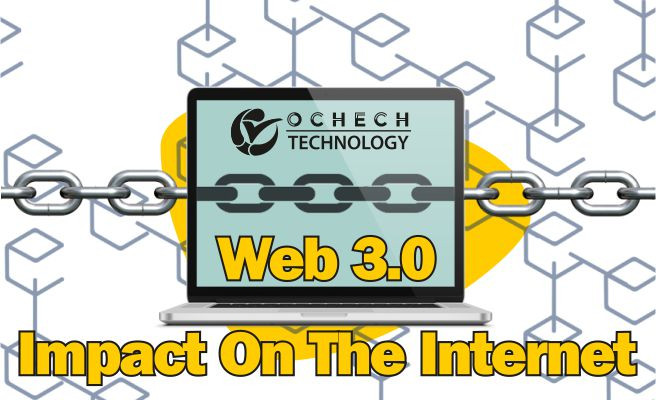
The basics of Web 3.0 and its potential impact on the internet
INTRODUCTION
Web 3.0 is the next evolution of the internet, and it has the potential to revolutionize the way we interact with the web. Unlike Web 1.0 and 2.0, which were primarily focused on the dissemination of information and the development of interactive platforms, Web 3.0 aims to create a more decentralized and intelligent internet, where users can interact with each other and with machines in a more seamless and efficient way. The key concept behind Web 3.0 is decentralization, and it is powered by advanced technologies such as blockchain, smart contracts, decentralized storage, and semantic web technologies. The decentralization of the internet, enabled by web3.0, has the potential to give users more control over their data and online identity, increase data privacy and security, and create new forms of digital ownership and value transfer. This article aims to provide an overview of the basics of Web 3.0 and its potential impact on the internet. It will cover the key concepts and technologies of Web 3.0, the role of blockchain in web3, the implications of web3 on various industries, the challenges and limitations of web3 adoption, and its future outlook.
COMPARISON TO WEB 1.0, 2.0 AND 3.0
Web 1.0, also known as the "Static Web", was the first generation of the World Wide Web, characterized by the dissemination of information through simple, static websites that were primarily used to share text and images. The primary focus of Web 1.0 was to make information available to as many people as possible, but it did not allow for much user interaction or collaboration.
Web 2.0, also known as the "Interactive Web", was the second generation of the World Wide Web, characterized by the development of interactive platforms such as social media, e-commerce, and online communities. It allowed users to interact with each other, share content and collaborate on projects, and enabled businesses to create dynamic, interactive websites. Web 2.0 also saw the rise of cloud computing and mobile devices, which made it easier for users to access the internet from anywhere.
Web 3.0, also known as the "Semantic Web" or the "Intelligent Web", is the next stage of the development of the World Wide Web, characterized by the use of advanced technologies like blockchain, artificial intelligence, and decentralized storage to create a more intelligent, decentralized and user-controlled internet. Web 3.0 aims to create a web that is more aware of its users, their needs, and their context, and can adapt to them in real-time. Web 3.0 is also designed to be more open, transparent, and inclusive, where users have more control over their data and online identity, and where machines can communicate and interact with each other in a more efficient and seamless way.
KEY CONCEPTS AND TECHNOLOGIES OF WEB 3.0
Decentralization: Web 3.0 is built on the concept of decentralization, which means that it is not controlled by a single entity or organization, but rather by a network of users and machines. Decentralization is achieved through the use of blockchain technology and peer-to-peer networks.
Blockchain technology: Blockchain is a decentralized digital ledger that records transactions across a network of computers. It is the foundation of Web 3.0, and enables the creation of decentralized applications (dApps), digital currencies, and smart contracts.
Smart Contracts: Smart contracts are self-executing digital contracts that are stored on the blockchain and automatically enforce the terms of a contract. They are used to automate complex business processes and reduce the need for intermediaries.
Decentralized storage: Decentralized storage refers to the use of distributed networks to store data and files, rather than relying on centralized servers. This ensures data privacy and security, and makes it more difficult for hackers to access or corrupt data.
The semantic web: The semantic web is an extension of the current web, in which information is given a well-defined meaning, making it more easily understandable by machines. With the rise of web3.0 the semantic web technologies such as RDF, OWL, and SPARQL are becoming more important, as they provide a way for machines to understand the meaning of web pages and data.
Artificial Intelligence: AI plays a vital role in web3.0, as it enables the creation of intelligent agents and automated processes that can understand and adapt to users' needs and context.
Interoperability: Web 3.0 aims to create a more interoperable internet, where different platforms, networks, and applications can communicate and interact with each other in a seamless way.
Identity and access management: Web3.0 also aims to create a more secure and transparent way of managing identities and access control, using technologies such as Self-sovereign identity and decentralized identity.
Web3 technologies like IPFS, Distributed Hash Table and peer-to-peer networks are also important concepts of web3.0 as they provide a more efficient, scalable and secure way of storing and sharing data.
THE IMPACT OF WEB 3.0 ON THE INTERNET
Web 3.0 has the potential to significantly impact the way we interact with the internet. Some of the key ways in which Web 3.0 could impact the internet include:
Decentralization and peer-to-peer networks: Web 3.0 is built on the concept of decentralization, which means that it is not controlled by a single entity or organization, but rather by a network of users and machines. This is achieved through the use of blockchain technology and peer-to-peer networks, which enable the creation of decentralized applications (dApps) and digital currencies.
Increased data privacy and security: With Web 3.0, users will have more control over their data and online identity, and the decentralized nature of the internet will make it more difficult for hackers to access or corrupt data.
New forms of digital ownership and value transfer: Web 3.0 technologies such as blockchain and smart contracts enable new forms of digital ownership and value transfer, such as non-fungible tokens (NFTs) and decentralized finance (DeFi).
Changes in the way we interact with online platforms and services: Web 3.0 has the potential to change the way we interact with online platforms and services, and the implications for businesses and consumers. The rise of decentralized marketplaces, for example, could disrupt traditional e-commerce models.
Interoperability: Web 3.0 aims to create a more interoperable internet, where different platforms, networks, and applications can communicate and interact with each other in a seamless way.
Identity and access management: Web 3.0 also aims to create a more secure and transparent way of managing identities and access control, using technologies such as Self-sovereign identity and decentralized identity.
Overall, the impact of Web 3.0 on the internet is still uncertain, but it has the potential to create a more open, transparent, and inclusive internet, where users have more control over their data and online identity.
THE ROLE OF BLOCKCHAIN TECHNOLOGY IN WEB 3.0
Blockchain technology is a key component of Web 3.0 and plays a crucial role in enabling the decentralization of the internet. Blockchain is a decentralized digital ledger that records transactions across a network of computers. It is the foundation of Web 3.0, and enables the creation of decentralized applications (dApps), digital currencies, and smart contracts.
Decentralized Applications (dApps): Blockchain technology enables the development of decentralized applications (dApps) that can run on a peer-to-peer network, without the need for intermediaries. This allows for a more open and transparent way of creating and using applications, and gives users more control over their data and online identity.
Digital Currencies: Blockchain technology is also the foundation of digital currencies such as Bitcoin and Ethereum. These digital currencies enable new forms of value transfer and can be used to facilitate decentralized finance (DeFi) transactions.
Smart Contracts: Smart contracts are self-executing digital contracts that are stored on the blockchain and automatically enforce the terms of a contract. This allows for the automation of complex business processes and reduces the need for intermediaries.
Transparency and Immutability: Blockchain technology provides transparency and immutability, as all transactions are recorded on a public ledger that is accessible to all network participants. This ensures that transactions are recorded in a tamper-proof manner and can be audited at any time.
Security: Blockchain technology provides a high level of security, as it is resistant to tampering and hacking, and it makes it more difficult for hackers to access or corrupt data.
DECENTRALIZED FINANCE (DEFI) IN WEB 3.0
Decentralized finance (DeFi) is a rapidly growing area of Web 3.0, and it has the potential to disrupt traditional banking and financial systems. DeFi refers to the use of blockchain technology and smart contracts to create decentralized financial applications and services that can operate without intermediaries.
Decentralized exchanges (DEXs): Decentralized exchanges (DEXs) are platforms that enable peer-to-peer trading of digital assets without the need for a central intermediary. These platforms are built on blockchain technology and use smart contracts to automatically execute trades.
Stablecoins: Stablecoins are digital assets that are pegged to the value of a fiat currency or a commodity. They are designed to provide a stable store of value and can be used to facilitate decentralized finance transactions.
Decentralized lending and borrowing platforms: Decentralized lending and borrowing platforms use smart contracts to automate the lending process and enable peer-to-peer lending without the need for intermediaries.
Decentralized insurance: Decentralized insurance platforms use smart contracts to automate the process of insuring assets, and they can operate without intermediaries.
Decentralized prediction markets: Decentralized prediction markets platforms use smart contracts to enable users to bet on the outcome of events, and they can operate without intermediaries.
DeFi has the potential to democratize access to financial services and provide new opportunities for individuals and businesses to access capital and manage risk. However, it is still a relatively new and rapidly evolving area, and there are several challenges and limitations that need to be addressed before it can reach its full potential.
NON-FUNGIBLE TOKENS (NFTS) IN WEB 3.0
Non-Fungible Tokens (NFTs) are a key component of Web 3.0 and play a significant role in creating new forms of digital ownership and value transfer. NFTs are unique digital assets that are stored on a blockchain and can represent ownership of a wide range of assets, such as digital art, music, videos, and more.
Digital Ownership: NFTs enable the creation of unique digital assets that can be owned and traded, just like physical assets. They allow creators to monetize their work and give collectors the ability to own a piece of digital art, music, videos and more.
Authenticity and provenance: NFTs provide a tamper-proof way to verify the authenticity and provenance of digital assets. The information stored on the blockchain cannot be modified, and this makes it possible to track the ownership and provenance of an asset throughout its entire life cycle.
Liquidity: NFTs enable the creation of a liquid market for digital assets, making it easy to buy, sell, and trade unique digital items. This creates new opportunities for creators and collectors to monetize their assets and access new forms of value.
Interoperability: NFTs are stored on a blockchain, and this makes them interoperable with other platforms and services that can access the blockchain. This allows for the creation of new use cases, such as the integration of NFTs into games, virtual worlds, and other digital experiences.
Gamification and Collecting: NFTs also open up new opportunities for gamification and collecting. By owning an NFT, users can access special features, such as in-game bonuses, special access to content, or the ability to vote on community proposals.
NFTs are a key component of Web 3.0, and they enable the creation of unique digital assets that can be owned and traded, providing authenticity and provenance, liquidity, interoperability, and gamification. As the technology matures and more use cases are developed, it will be interesting to see how NFTs will continue to change the way we think about ownership and value transfer in the digital world.
POTENTIAL CHALLENGES AND LIMITATIONS OF WEB 3.0
Web 3.0 is a relatively new and rapidly evolving technology, and it still faces several challenges and limitations that need to be addressed before it can reach its full potential. Some of the key challenges and limitations of Web 3.0 include:
Scalability: The current infrastructure of blockchain and peer-to-peer networks is not yet able to handle the volume of transactions required for mainstream adoption. This is a significant limitation that needs to be addressed before Web 3.0 can be fully realized.
Governance: Decentralized systems like blockchain and peer-to-peer networks are still in the process of developing governance models that can effectively manage the network. This is important for making sure that the network remains secure, stable, and can adapt to changing needs.
Adoption and implementation: Web 3.0 is still in the early stages of adoption, and it will take time for users, businesses and developers to understand and fully adopt the technology. Additionally, many of the existing web3 technologies are still in the development stages and have not yet been fully implemented.
Regulation: Web 3.0 technologies such as blockchain and digital currencies are not yet fully regulated, and this lack of regulation could be a hindrance to mainstream adoption. Governments and regulatory bodies will need to establish a framework for regulating these technologies to ensure that they are safe and compliant.
Usability: Web3 technologies are still not as user-friendly as the web2.0 technologies, and this could be a limitation for the general public to adopt the technology.
Interoperability: While Web 3.0 aims to create a more interoperable internet, the current state
FINAL TAKEAWAY
In conclusion, Web 3.0 is the next evolution of the internet, characterized by decentralization, semantic understanding, and machine intelligence. It aims to create a more open, transparent and inclusive internet, where users have more control over their data and online identity. Key technologies that power Web 3.0 include blockchain, smart contracts, decentralized storage, and semantic web technologies. These technologies are enabling new forms of digital ownership and value transfer, such as Non-Fungible tokens (NFTs) and decentralized finance (DeFi).
However, Web 3.0 still faces several challenges and limitations that need to be addressed before it can reach its full potential. Scalability, governance, adoption and implementation, regulation, usability and interoperability are some of the most important challenges that need to be overcome. Governments and regulatory bodies will need to establish a framework for regulating these technologies to ensure that they are safe and compliant.
The future outlook for Web 3.0 is promising as it has the potential to revolutionize the way we interact with the internet. The technology is still in its early stages and it will take time for users, businesses and developers to fully understand and adopt it. The potential of Web 3.0 is yet to be fully realized, and it will be interesting to see how it continues to shape the internet in the future.








